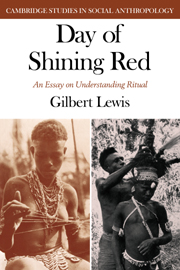Book contents
- Frontmatter
- Contents
- Analytical table of contents
- Preface
- 1 A question of interpretation
- 2 Problems of ritual in general
- 3 Views from one village
- 4 The rites of puberty seen
- 5 Rules of procedure and reflection on them
- 6 Silent forms but natural symbols?
- 7 Moon, river and other themes compared
- 8 For success in life
- 9 A choice of magic
- 10 Change and a rite falling into disuse
- 11 Inventory of themes
- References
- Index
- CAMBRIDGE STUDIES IN SOCIAL ANTHROPOLOGY
- Frontmatter
- Contents
- Analytical table of contents
- Preface
- 1 A question of interpretation
- 2 Problems of ritual in general
- 3 Views from one village
- 4 The rites of puberty seen
- 5 Rules of procedure and reflection on them
- 6 Silent forms but natural symbols?
- 7 Moon, river and other themes compared
- 8 For success in life
- 9 A choice of magic
- 10 Change and a rite falling into disuse
- 11 Inventory of themes
- References
- Index
- CAMBRIDGE STUDIES IN SOCIAL ANTHROPOLOGY
Summary
The search for cognitive content and possible symbols in other people's rites outweighs concern for what people may feel about them. I think this neglect may distort their just interpretation. Anthropologists sometimes treat rites rather like a set of clues or a test to be solved by finding answers that all fit together. It is as though the cry ‘It fits’ would convincingly repay the effort and the ingenuity. Rites come to seem like riddles or crossword puzzles. But if the actions were not clues, the rites not intellectual games …? If there were no right solution …?
Smell, colour, noise, actions that hurt, exhaust, excite, satiate seem clearly designed to act on the senses and emotions. They provoke responses. They do not necessarily suggest solutions to problems or answers to questions. There may be no set message to be deciphered. Among the variety of responses evoked, some people may think of answers to satisfy an intellectual impulse. The question is whether there is only one correct solution or rather many partial answers. The search to find a ‘right’ solution presumes that a problem has been set, or an answer provided in the rite. That a problem or answer in that sense exists may be imaginary. What the analysis may explain sometimes is why the actions chosen are suited to provoke or elicit the responses they do. If there were something to find in the rites, it might resemble the chimera or the hydra rather than the unicorn.
- Type
- Chapter
- Information
- Day of Shining Red , pp. 186 - 199Publisher: Cambridge University PressPrint publication year: 1980

